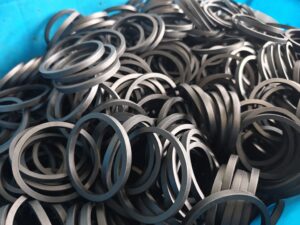Gaskets are generally used for sealing between stationary parts, while rubber seals are more flexible and suited for dynamic or moving parts.

A gasket and a rubber seal are both used to prevent leakage of fluids or gases in mechanical systems, but they have distinct differences in their design, material, and application:
Gasket:
- Material: Gaskets can be made from a variety of materials, including rubber, metal, cork, silicone, and paper. The material is selected based on the environment (e.g., temperature, pressure, and chemical exposure).
- Function: Gaskets fill the space between two mating surfaces (e.g., between flanges) to prevent leakage when the surfaces are bolted together. They work by compressing when tightened to form a tight seal.
- Shape: Gaskets are often flat and cut into shapes like rings, sheets, or custom designs to fit between components.
- Common Use: Gaskets are widely used in engines, pipes, and industrial systems where fluids, gases, or vapors must be contained between two stationary parts.
Rubber Seal (O-Ring or Sealing Ring):
- Material: Rubber seals are typically made of flexible materials such as natural rubber, silicone rubber, neoprene, or other elastomers.
- Function: Rubber seals are designed to close off gaps between moving parts and prevent the escape of fluids or air. They maintain their shape and return to their original form after being compressed.
- Shape: Rubber seals are often circular (like O-rings) or have other shapes like lip seals, and are placed in grooves to ensure proper sealing.
- Common Use: Rubber seals are used in dynamic applications where parts move relative to each other (e.g., shafts, hydraulic cylinders, rotating equipment) and require flexible, resilient sealing solutions.
In summary, gaskets are generally used for sealing between stationary parts, while rubber seals are more flexible and suited for dynamic or moving parts.







